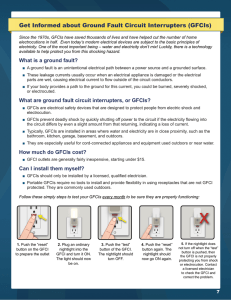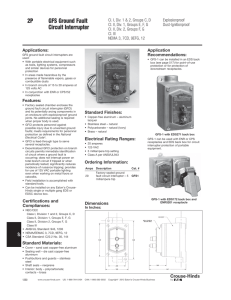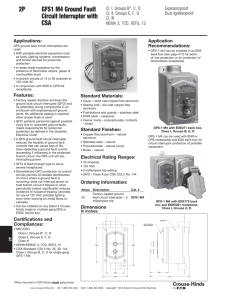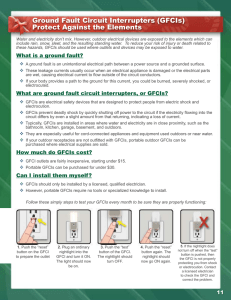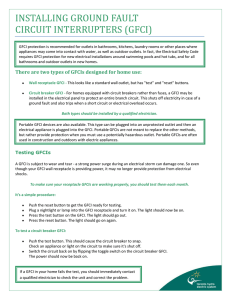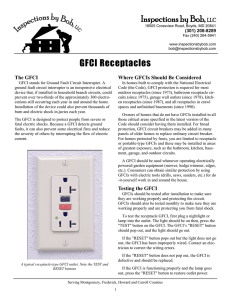ground fault circuit interrupters - American Fire Sprinkler Association
advertisement
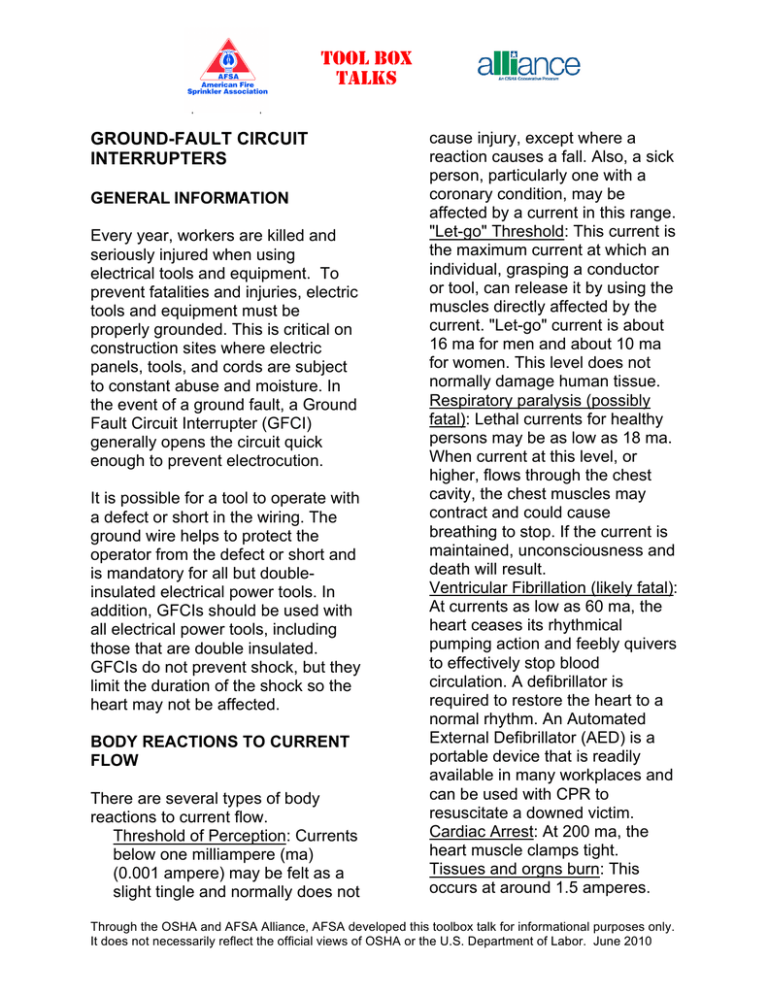
TOOL BOX TALKS GROUND-FAULT CIRCUIT INTERRUPTERS GENERAL INFORMATION Every year, workers are killed and seriously injured when using electrical tools and equipment. To prevent fatalities and injuries, electric tools and equipment must be properly grounded. This is critical on construction sites where electric panels, tools, and cords are subject to constant abuse and moisture. In the event of a ground fault, a Ground Fault Circuit Interrupter (GFCI) generally opens the circuit quick enough to prevent electrocution. It is possible for a tool to operate with a defect or short in the wiring. The ground wire helps to protect the operator from the defect or short and is mandatory for all but doubleinsulated electrical power tools. In addition, GFCIs should be used with all electrical power tools, including those that are double insulated. GFCIs do not prevent shock, but they limit the duration of the shock so the heart may not be affected. BODY REACTIONS TO CURRENT FLOW There are several types of body reactions to current flow. Threshold of Perception: Currents below one milliampere (ma) (0.001 ampere) may be felt as a slight tingle and normally does not cause injury, except where a reaction causes a fall. Also, a sick person, particularly one with a coronary condition, may be affected by a current in this range. "Let-go" Threshold: This current is the maximum current at which an individual, grasping a conductor or tool, can release it by using the muscles directly affected by the current. "Let-go" current is about 16 ma for men and about 10 ma for women. This level does not normally damage human tissue. Respiratory paralysis (possibly fatal): Lethal currents for healthy persons may be as low as 18 ma. When current at this level, or higher, flows through the chest cavity, the chest muscles may contract and could cause breathing to stop. If the current is maintained, unconsciousness and death will result. Ventricular Fibrillation (likely fatal): At currents as low as 60 ma, the heart ceases its rhythmical pumping action and feebly quivers to effectively stop blood circulation. A defibrillator is required to restore the heart to a normal rhythm. An Automated External Defibrillator (AED) is a portable device that is readily available in many workplaces and can be used with CPR to resuscitate a downed victim. Cardiac Arrest: At 200 ma, the heart muscle clamps tight. Tissues and orgns burn: This occurs at around 1.5 amperes. Through the OSHA and AFSA Alliance, AFSA developed this toolbox talk for informational purposes only. It does not necessarily reflect the official views of OSHA or the U.S. Department of Labor. June 2010 TOOL BOX TALKS GROUND FAULT CIRCUIT INTERRUPTERS Page 2 GFCI detects this "leakage" and deenergizes (opens) the circuit. However, the GFCI will not protect the worker from line-to-line contact hazards (such as a worker holding two "hot" wires or a hot wire in one hand and a neutral wire in the other hand). It does provide protection against the most common form of electrical shock hazards—the ground fault. It also provides protection against fires, which can be caused by arcing ground faults. GROUND FAULT CIRCUIT INTERRUPTER FUNCTION A typical electric circuit consists of a "hot" conductor that supplies power to the electric device, the device itself, and a return conductor. Ideally, all the current that enters the "hot" conductor should flow through the electrical device and then into the return (neutral) conductor. When an electric tool is functioning properly, all the current that flows into it should also flow out of it through the intended path—the neutral conductor. When an electric fault or "leak" develops, the return current is less than the current supplied. The difference flows through ground via some unintended path, such as a worker grasping a tool. The fault current can cause electric shock resulting in serious injury or electrocution. The cause of the "leak" is usually damaged insulation. The A GFCI opens a circuit (within as little as 1/40 of a second) when a relatively small amount of current strays from its intended path. It must be noted that GFCIs detect and operate at 4 to 6 milliamperes but do NOT limit the magnitude of the current although they DO limit the current’s duration. A person’s natural reflex reaction to an electric shock can result in an injury, such as a fall from a ladder. GFCI TYPES/USAGE The common types of ground fault circuit-interrupters are as follows: • GFCI Type Circuit Breaker – Located at the power supply or in a circuit breaker panel controlling all outlets in a circuit. The GFCI–type circuit breaker serves a dual purpose —not only will it shut off electricity in the event of a "ground fault," but it will also trip when a short circuit or an overload occurs. Protection by the Through the OSHA and AFSA Alliance, AFSA developed this toolbox talk for informational purposes only. It does not necessarily reflect the official views of OSHA or the U.S. Department of Labor. June 2010 TOOL BOX TALKS GROUND FAULT CIRCUIT INTERRUPTERS Page 3 GFCI covers the wiring and each outlet served by the branch circuit. • Receptacle Type – This type of GFCI is used in place of a standard duplex receptacle. It fits into the standard outlet box and protects against "ground faults" whenever electric equipment is plugged into the outlet. Receptacle-type GFCIs can be installed so that they also protect other electrical outlets in the branch circuit. All GFCI circuitry is contained in the unit. • Portable Adapter – Where permanent GFCIs are not practical, portable GFCI adapter devices can be used. One type contains the GFCI circuitry in a plug-in enclosure with receptacle slots in the front. It can be plugged into a standard receptacle; then, electric equipment is plugged into it. Another type of portable GFCI is a short extension cord combined with a GFCI receptacle outlet at its end. It adds flexibility in using receptacles that are not protected by GFCIs. Portable GFCI adapters are convenient for construction sites. They allow protection and ease of movement for workers going from one location to another. All GFCIs should be checked and returned to their proper storage location at the end of the day. PREVENTING AND ELIMINATING HAZARDS GFCIs can be used to protect against electrical hazards on construction sites. Tripping of GFCIs (interruption of current flow) is sometimes caused by wet connectors and tools. It is good practice to limit exposure of connectors and tools to excessive moisture by using watertight or sealable connectors. Providing additional GFCIs and shorter cords can also prevent tripping caused by the cumulative leakage from several tools or by leakages from extremely long circuits. Sources: American Insurance Services Group, Ground Fault Protection for Electrical Tools, 1995. Through the OSHA and AFSA Alliance, AFSA developed this toolbox talk for informational purposes only. It does not necessarily reflect the official views of OSHA or the U.S. Department of Labor. June 2010
